Redirect to “Connecting Families to your School” resource page
Interest: Family Engagement
Raising the Bar with the National Standards for Family-School Partnerships
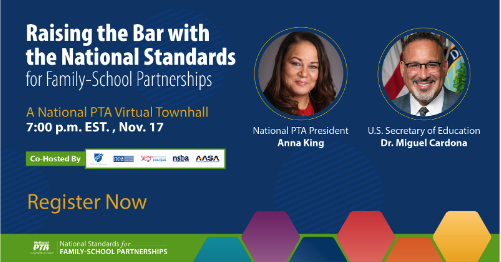 Families are essential partners in providing a high-quality education for every student. National PTA’s National Standards for Family-School Partnerships set the bar for how schools and parents should work together to support student success. The updated Standards provide critical guidance and best practices for strong partnerships that will make a real impact for all students, families and schools. National PTA, alongside other leading education organizations, will host a virtual townhall Nov. 17 at 7 p.m. EST in conjunction with National Parent Involvement Month. The townhall will be streamed live on National PTA’s Facebook page and Twitter and YouTube accounts.
Families are essential partners in providing a high-quality education for every student. National PTA’s National Standards for Family-School Partnerships set the bar for how schools and parents should work together to support student success. The updated Standards provide critical guidance and best practices for strong partnerships that will make a real impact for all students, families and schools. National PTA, alongside other leading education organizations, will host a virtual townhall Nov. 17 at 7 p.m. EST in conjunction with National Parent Involvement Month. The townhall will be streamed live on National PTA’s Facebook page and Twitter and YouTube accounts.
Angst: Film Screening & Panel Discussion

Health and Community Concerns and Family Engagement are showing Angst, a documentary that explores anxiety; its causes, effects, and what we can do about it – with an emphasis on youth and families. After the showing there will be a Q&A session with a panel of experts.
WHEN: May 25th | 7-8:30pm
REGISTER TO WATCH ANGST & JOIN THE DISCUSSION
WATCH THE TRAILER
Trends in Education Parents Need to Know
July 24, 2018
Media Contacts:
- Brad Waller, Vice President for Communications, bwaller@capta.org
- Michelle Eklund, Assistant Executive Director, 951-314-3707 or meklund@capta.org
With thousands of kids heading back to school starting as early as next week, California State PTA offers the top three trends in education during this back-to-school season.
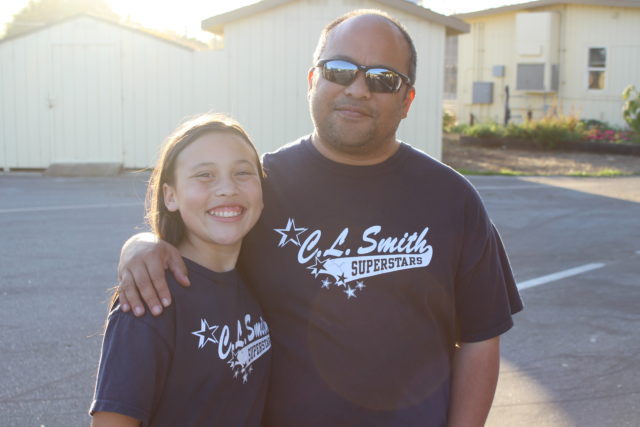
Family engagement leads to student success. Research shows that authentic family engagement is a key factor in long-term student success – including better student attendance, higher graduation rates and increased student achievement. That’s why we’re proud to sponsor Assembly Bill 2878 (Chavez). This important measure is a family engagement bill that seeks to use research-based guidelines to define what authentic family engagement could look like in Education Code in order to guide schools, districts and county offices of education.
Safe children are better learners. We believe that every child is entitled to a safe and peaceful school environment that is orderly and empowering, in which students and staff are free to learn and teach without the threat of physical and psychological harm. When kids feel safe and secure, they can better focus on learning at school and in the home, and can achieve academic success.
It starts with attendance. Children need to be in school to learn – it’s that simple. If children don’t show up for school every day, they miss out on developing fundamental skills. Data shows children who are chronically absent in kindergarten and first grade are far less likely to read proficiently at the end of third grade. Parents and families are essential partners in making sure students attend school, and play a key role in identifying the barriers to attendance as well as what motivates students to go to school.
“Family engagement makes an amazing impact on student success, along with good attendance and school safety. These trends in education support our mission of support every child in California, both at school and in the home,” said California State PTA President Dianna MacDonald.
For more information on these trends and many more resources, visit www.capta.org/tips-for-parents.
Understanding the Visual and Performing Arts Standards
PARENTS’ GUIDE TO ARTS EDUCATION IN CALIFORNIA PUBLIC SCHOOLS
 California State PTA in partnership with Create CA is pleased to launch the newly revised Parents’ Guide to Arts Education in California Public Schools. This guide provides an overview of what your child will learn in the arts disciplines of dance, music, theatre and the visual arts by the end of each grade level.
California State PTA in partnership with Create CA is pleased to launch the newly revised Parents’ Guide to Arts Education in California Public Schools. This guide provides an overview of what your child will learn in the arts disciplines of dance, music, theatre and the visual arts by the end of each grade level.
By asking about the arts program at your child’s school, you are showing your interest in all students, not just the “talented,” having the opportunity to express their unique individuality through creating and learning in and through the arts.
The information is grouped into four sections:
- Grades Pre-K-2: English Spanish Chinese
- Grades 3-5: English Spanish Chinese
- Grades 6-8: English Spanish Chinese
- Grades 9-12: English Spanish Chinese
Download the full guide here:
EXPLORE
- A snapshot of your child as they experience the arts in their classroom at each grade level.
- A few key examples of what is typically taught in dance, music, theatre and the visual arts at each grade level to use as a starting point in talking to
your child’s teacher. - Questions to ask the teacher about your child’s progress in arts learning and about the school’s arts program.
- Ideas for what you can do to help your child learn in the arts at school, at home and in the community.
- If you are interested in expanding or improving the visual and performing arts program at your child’s school, key resources for getting started are provided.
The arts learning examples in this guide are based on the Visual and Performing Arts Framework for California Public Schools, the California Visual and Performing Arts Content Standards and the National Core Arts Standards. While standards in every subject area are revised over the years, if your child is being provided with the type of arts content suggested here in each grade, he or she will be well prepared for learning in the arts in each grade level.
“California State PTA is excited to provide this arts curriculum guide for parents and education advocates across California. In partnership with CREATE CA, California State PTA has put together a simple, easy-to-read guide of the Visual and Performing Arts (VAPA) Standards by grade level. This guide, in conjunction
with the California Arts Education Data Project, will give parents and education advocates a snapshot of how a full arts curriculum advances student success socially, emotionally and academically.” – Celia Jaffe, President, California State PTA
Four Big Upgrades to California’s Public Schools
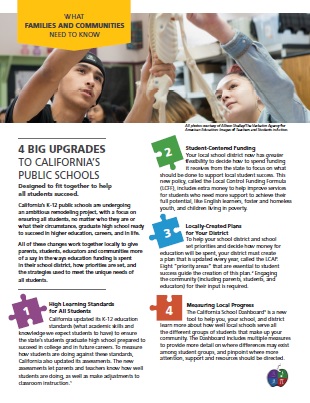 California’s K-12 public schools are undergoing an ambitious remodeling project, with a focus on ensuring all students, no matter who they are or what their circumstance, graduate high school ready to succeed in higher education, careers, and in life.
California’s K-12 public schools are undergoing an ambitious remodeling project, with a focus on ensuring all students, no matter who they are or what their circumstance, graduate high school ready to succeed in higher education, careers, and in life.
All of these changes work together locally to give parents, students, educators and communities more of a say in the ways education funding is spent in their school district, how priorities are set, and the strategies used to meet the unique needs of all students.
Upgrades include:
- High Learning Standards for All Students
- Student-Centered Funding
- Locally-Created Plans for Your District
- Measuring Local Progress.
How to Keep Kids Learning During Winter Break
The winter holiday break is a fun-filled time for you and your family to unwind and spend quality time together, but it will be over before you know it! Children’s school success begins at home, and even the simplest steps can mean a big difference for your child’s future. To keep your child’s skills sharp and ensure a smooth transition to going back to school, Scholastic offers tips to keep kids learning:

- Read for pleasure. Whether your child is in the mood for holiday favorites like The Night Before Christmas or their favorite series, winter break is the perfect chance to stash the schoolbooks and have fun reading.
- Cook up a lesson. Ask your child for help in the kitchen to whip up some treats. Using measurements is good math practice, especially in fractions!
- Write thank-you notes. Whether your child is writing notes to gift-givers, teachers or neighbors, this is a great way to practice penmanship, spelling and grammar – plus, it teaches gratitude.
- Let kids help with online shopping. Need a last minute gift? Help your child shop online with you to help them work on computer and research skills.
- Maintain reasonable bedtimes. With no school to wake up early for, it’s tempting to let your child become a night owl. A few days before school starts again, ease back into the regular schedule.
- Have a family game night. Chances are many of your family’s favorite card and board games reinforce skills like reading, counting and drawing. Gather your family to play games you don’t have time for on school nights.
- Make the most of car rides. Turn the drive to or from holiday gatherings into a fun opportunity to learn. You can look for license plates from different states, count the number of red or green cars you see or play license plate bingo!
Read more ways to keep skills sharp during winter break at www.scholastic.com, and learn how to support learning at home at www.capta.org/supporting-learning-at-home.
Six Ways to Engage Families in ESSA
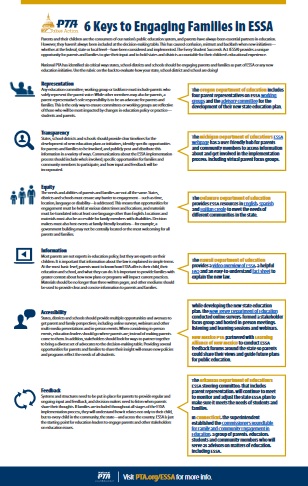 Parents and their children are the consumers of our nation’s public education system, and parents have always been essential partners in education. However, they haven’t always been included at the decision-making table. This has caused confusion, mistrust and backlash when new initiatives — whether at the federal, state or local level—have been considered and implemented.
Parents and their children are the consumers of our nation’s public education system, and parents have always been essential partners in education. However, they haven’t always been included at the decision-making table. This has caused confusion, mistrust and backlash when new initiatives — whether at the federal, state or local level—have been considered and implemented.
The Every Student Succeeds Act (ESSA) provides a unique opportunity for parents and families to give their input and to hold states and districts accountable for their children’s educational experience.
National PTA has identified six critical ways states, school districts and schools should be engaging parents and families as part of ESSA or any new education initiative. Use the rubric on the back to evaluate how your state, school district and school are doing!
Harvard Family Research Project
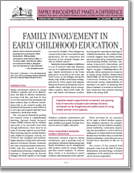 Family Involvement Makes a Difference is a set of research briefs from the Harvard Family Research Project that examines one set of complementary learning linkages: family involvement in the home and school. The briefs in this series examine family involvement in early childhood, elementary school, and middle and high school settings. Taken together, these briefs make the case that family involvement predicts children’s academic achievement and social development as they progress from early childhood programs through K–12 schools and into higher education.
Family Involvement Makes a Difference is a set of research briefs from the Harvard Family Research Project that examines one set of complementary learning linkages: family involvement in the home and school. The briefs in this series examine family involvement in early childhood, elementary school, and middle and high school settings. Taken together, these briefs make the case that family involvement predicts children’s academic achievement and social development as they progress from early childhood programs through K–12 schools and into higher education.
Family Engagement Practices in CA Schools
 A recent report by the Public Policy Institute of California (PPIC) identifies promising family engagement strategies from a review of 15 high-need districts in the state, noting that effective strategies are culturally appropriate and aim to support student learning at home.
A recent report by the Public Policy Institute of California (PPIC) identifies promising family engagement strategies from a review of 15 high-need districts in the state, noting that effective strategies are culturally appropriate and aim to support student learning at home.